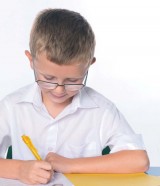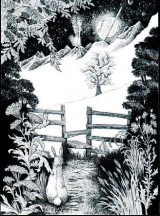Is your class struggling to kick start the creative process? Stoking the fires of their imaginations is a simple as tossing a coin...
Have you ever been in a conversation where you’ve wanted to remember someone’s name, known it was ‘on the tip of the tongue’ and tried hard to recall it? If so, you probably found that the effort and struggle, rather than bringing the name to mind, made it even more elusive and distant. Faced with this situation, most people wisely give up and say “Oh never mind, it’ll come to me.” And usually, of course, it does, often moments later and with a feeling of certainty that yes, that’s the name I was after!
This is a common phenomenon but a useful one too, as far as developing children’s thinking and creativity are concerned. What we learn from the experience is that:
 • Trying hard usually doesn’t get you the result, but ‘letting go’ often does.
• Trying hard usually doesn’t get you the result, but ‘letting go’ often does.
• The feeling of certainty accompanies and verifies the information that suddenly pops into mind. (Such a feeling can be more subtle, letting you know, for example, that you’ve got the surname right but not the first name.)
• The overall experience of ‘yes, that’s the name!’ is a pleasant one, combining the certainty mentioned above with feelings of relief that you now consciously have the name to hand, and a sense of achievement that your brain has ‘come up with the goods’.
Children frequently encounter the same sense of frustration when they struggle to have ideas – for a piece of creative writing, for example. I’ve been told many times by young writers that they couldn’t think of any ideas in the first place, or that they ran out of ideas halfway through their story. By the same token, classes I speak to often ask me “Where do you get your ideas from?”, as though it is a mysterious process or a special talent that only ‘creative people’ possess.
Enrich the activity by showing children how to reformulate an open question as a number of closed ones. So, “Why is the hare there?” could turn into:
 • Is the hare there because he is on an adventure?
• Is the hare there because he is on an adventure?
• Is the hare there because he’s been imprisoned in a strange world?
• Is the hare there because he wants to be?
• Is the hare there because he’s the hero of the story?
In fact, all children can access the rich resource of their imaginations given the right strategies. Many of these can be built around an insight offered by de Bono, that the introduction of randomness and chance into the thinking process aids creativity. But how can this be achieved?
One of the simplest ways is to flip a coin. Let’s use the illustration below to explore the idea.
The fascinating picture Hare and Cosmos by artist Stella Hender could easily serve as a stimulus for creative writing. But simply showing your class the image and asking the children to write a story about it might give rise to the struggle and frustration mentioned above. Instead, ask each child to think of a question that can be answered yes or no. For each question, flip the coin to select the answer.
The immediate value of the technique is that:
• It breaks a vague idea down into a number of more specific possibilities.
• It emphasises the importance of enquiry.
• It removes the fear of the wrong answer. I tell children that while they are responsible for asking relevant questions, the coin is responsible for the answers.
• It allows children to think ‘unanticipated thoughts’. After five minutes of coin flipping the class will be coming up with ideas / questions that they would probably never otherwise have thought of.
• It effortlessly generates information that acts as the raw material for writing.
A further benefit is that if the coin indicates yes then children have a definite idea they can explore further. If the coin comes up no then the children have to think of another possibility: i.e. the game creates a ‘positive pressure’ to keep on thinking and asking.
Try the coin-flip technique with your class for 15 minutes to demonstrate how quickly ideas accumulate. Incidentally, you may find that the children want to carry on ‘to find out what happens next’
1. Run the coin-flip game with children in groups or pairs. Ask each group to generate 20 pieces of positive information – i.e. ‘yes’ answers only. Then invite the children to review the ideas they’ve got and say to them “If there are any answers that you would change, for reasons you’ve thought about, that would make your story better, then go ahead and change them.” This hands control of the whole activity over to the children and gives them the experience of reflecting on why their ideas are relevant.
2. Use a narrative line as a planning tool for stories. Simply have each child or group draw a line on a large sheet of paper and place a prompt word anywhere along it.
Using our example, say to the class “All we know about this story is that there is danger just after the middle.” Now use the Big Question Words – where, when, what, who, why and how – to generate open questions that can each be reformulated as a number of closed ones. Have the groups flip the coin to create a cluster of ideas around the prompt word.
Now give the groups another prompt word – ‘chase’, for example. Ask them to put it somewhere else along the line and go through the same process. Even though the information is being generated randomly, a story that works will gradually emerge.
3. The coin-flip game works for creating characters too. A highly scaffolded version of the activity is to create two columns of words, for example, boy-girl, tall-short, fair hair-dark hair, etc. Make the columns around 10 pairs long and ask the class to help you do this. Ask children to flip the coin to select a word from each pair. If each child does this independently, everyone will come up with a different selection of descriptive details and so each child will have created his or her own unique character. Extend the game subsequently by having the children write a descriptive paragraph about their imaginary person.
The coin-flip game works well across a wide age and ability range. It allows children to work by themselves, but accommodates teamwork and collaborative learning too. It’s quick and easy to set up, requires minimal input from you but plenty of thinking and questioning from the children. All in all, a heads-you-win, tails-you-win situation.!
If any child or group starts to become confused or overwhelmed by the amount of information they generate, help them to delete or change some of the ideas until a narrative overview appears.
Should you let educational researchers into your classroom?
Ace-Classroom-Support
How to be a singing school
Ace-Music
Easy ways to combat teacher stress
Ace-Heads
